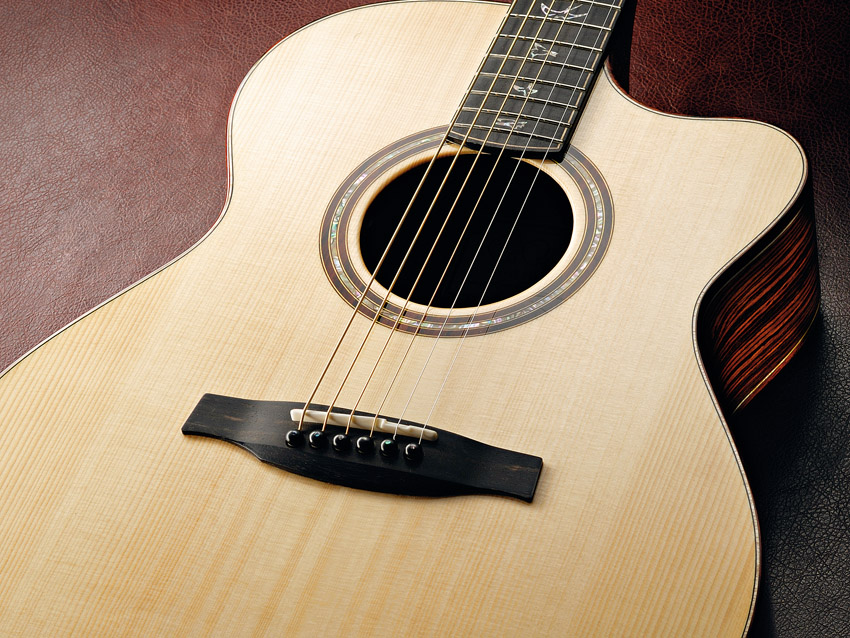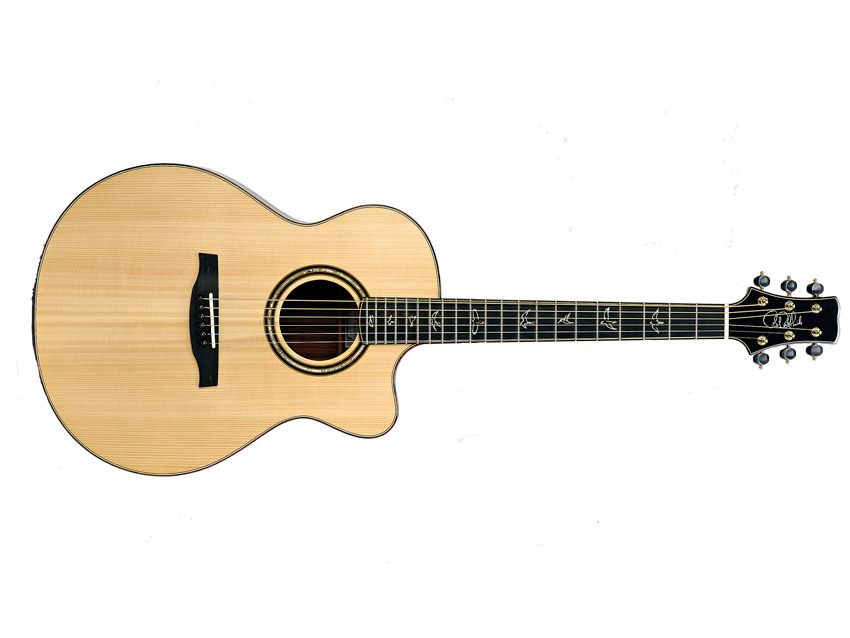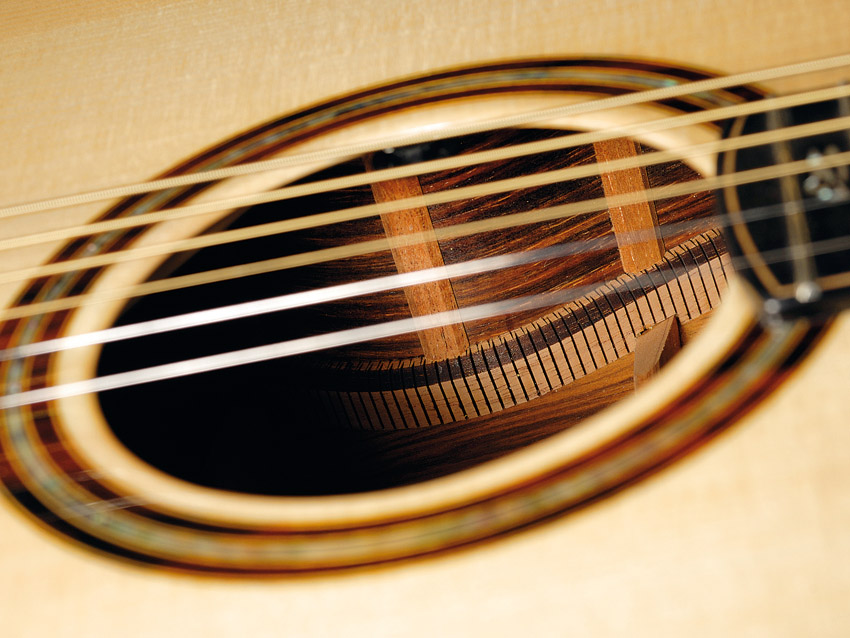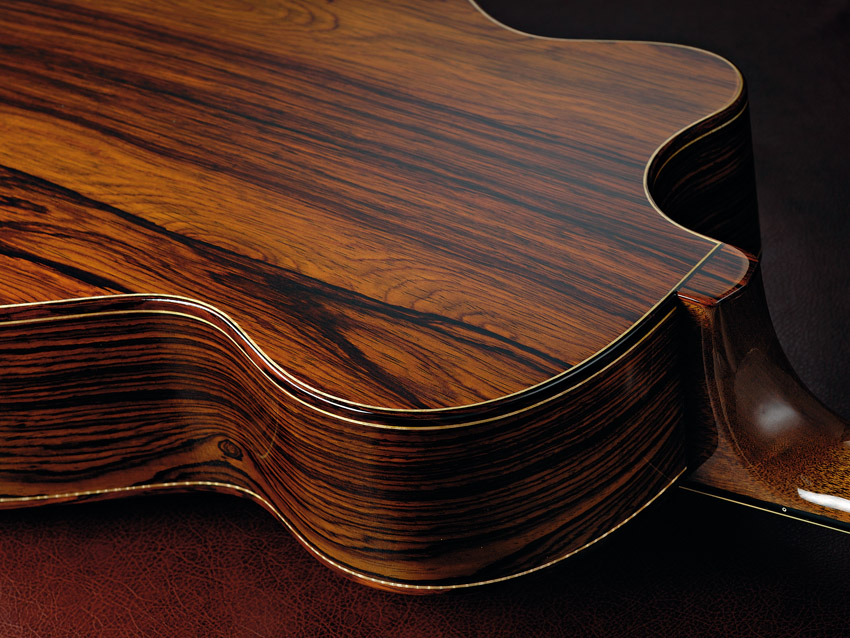MusicRadar Verdict
Undoubtedly one of the world's finest genuine all-rounder acoustic guitars… with a price to match!
Pros
- +
Incredible build quality. Balanced tone. Beautiful playability.
Cons
- -
Handling noise from the pickup. Price.
MusicRadar's got your back

PRS Angelus Custom

PRS Angelus Custom

PRS Angelus Custom

PRS Angelus Custom

PRS Angelus Custom
We got our first look at PRS's new acoustics in prototype form at the company's annual Experience event back in 2008. Having hired ex-McPherson man Steve Fischer, Smith was - and remains - near evangelical in his quest to prove that more can be done with the humble flat top.
Typically for Smith, we're not talking slavish vintage reissues - it's all about learning from the past and evolving. Two years later the guitars are finished, and with some fairly hard-hitting endorsement coming from the likes of Martin Simpson and Tony McManus, the team has obviously made some highly compelling instruments. So, take a look at that price, wipe the sweat from your brow, and let's see what they've come up with.
"The Angelus body uses cocobolo rosewood for the back and sides, a lovely figured selection."
The Angelus is one of two body styles from PRS acoustics. 394mm (15.5 inches) across the lower bout, cutaway and with a maximum depth of 111mm (4 3/8 inches), it finishes up halfway between Martin's 000 blueprint and the much-loved Taylor 514CE.
The rounded outline hints at mini jumbo territory, but PRS's other shape - the Tonare Grand - fits that description more comfortably. The guitar is built on a 641mm (25.25-inch) scale - again, part way between 000 Martin and Taylor-standard lengths - and has a 44.5mm (1.75-inch) nut, which is towards finger-style territory, but still manageable for comfortable chording.
The Angelus body uses cocobolo rosewood for the (ever so slightly arched) back and also the sides. It's a lovely figured selection that originates from the Yucatan peninsula in Mexico. The sides have strengthening struts - beautifully cut and shaped - while the lining is so fine and precise it could only have been done on a CNC machine.
Back outside, rosewood bindings are coach-lined with inlaid maple, with more rosewood and a ring of abalone around the soundhole: flawless. The top itself is Adirondack spruce, a highly prized variety thanks to its high strength-to-weight ratio and subsequent vibrational/tonal qualities.
What's more interesting, however, is what's going on underneath, which is mixture of 'standard' steel-string X-bracing, and the fan bracing you see more commonly in nylon-string classicals.
"The hybrid brace design came about because of an old Torres guitar that was owned by a friend of Paul's," explains Steve Fischer. "He and I thought [it] was possibly the most beautiful sounding acoustic instrument we had ever heard. Paul's friend was kind enough to let me take the guitar back to my shop in Utah, where I measured everything, examined everything inside and out and even had it X-rayed."
Fischer goes on to explain how the fan bracing seems, on a common sense level, to be a more natural way of bracing a resonating soundboard, though of course it will not stand up to the tension of steel strings. The solution?
"It came to me that if I could leave the X-brace and remove the diagonal tone bars normally found in a Martin X-brace pattern, and replace them with fan braces, it would be strong enough to withstand the pull of steel strings, but allow the top to move in a more natural and efficient way."
A feel inside the lower bout reveals the result: the X-brace crosses behind the soundhole as usual, then between the X, four fan braces run from just behind the bridge, tapering as they approach the rim.
The Angelus neck is a fairly chunky piece of Peruvian mahogany - one piece for the neck and headstock, with a single extra block for the lower third of the heel. It's joined to the body with a traditional dovetail - no bolts here, as Fischer believes that the marriage of body and neck is critically important in terms of resonance and that this is simply the right way to do it.
What's less traditional is the non-adjustable carbon fibre strengthening rod. For context, Martin used non-adjustable rods from the mid-1930s right up until 1985, when it phased in the adjustable rod.
Many players may still find the lack of adjustability a major point of concern, however. "It's solid and stable and shouldn't ever move," says Fischer confidently of his neck design. "Once we explain what we've done, it calms a lot of those worries."
Time will tell of course, but it's been two years of R&D with no issues yet, and in our month with the guitar, the neck hasn't moved a jot.
In terms of profile, this is a 'real' acoustic guitar. It's not skinny, but remains manageable with a comfortable 'C' section - which PRS calls 'wide fat'. As another example of the craftsmanship, consider the ebony fingerboard. It's a single piece of timber, with flawless PRS outline birds.
Then there's the inlaid maple coachline, which gives the impression of binding, but in fact the fret slots are cut just short of the edge, allowing the tangs to sit completely within the board, but with the - again flawless - fret ends running up to the edge of the board as you'd expect.
The sides of the ebony are then finished in glossy nitro-cellulose lacquer (as is the rest of the instrument) - but the face is left unfinished: truly breathtaking quality.
But it's not just aesthetics. The Angelus Custom is set up superbly, delivering effortless real-world playability (ie not an electric-style low action) all over the neck. A number of our staff and alumni have also commented how 'in-tune' it feels too, which is a testament to build tolerances, the nut and the intonation-compensated bone saddle.
Final appointments include the hand-tooled Keith Robson tuners - high-ratio and super stable in use - and a discreet electronics system comprising a McIntyre acoustic feather pickup that sticks on under the bridge just in front of the pins, and a PRS acoustic preamp. There's a single mini volume control just inside the soundhole: neat.
Sounds
Pick through some first-position chords and the first thing that hits you is the poise, balance and sheer clarity in the high-end. Those are traits that typify modern, quality American acoustic guitars for a lot of people and something you might associate with mid-body Taylors, for example, rather than classic Martins.
"Pick through some first-position chords and the first thing that hits you is the poise, balance and sheer clarity in the high-end."
The Angelus' upper end is more complex, however, suggesting a more European influence, where you don't have to dig in to the guitar quite so hard to get it singing. The scale might have something to do with that - long enough to keep a piano-like separation, yet not too long to kill the general 'togetherness' - but it's more likely the result of the hybrid-braced top. It doesn't feel 'soft', but for Adirondack spruce, it's notably touch sensitive and dynamic.
What might come as a surprise is that the impeccable behaviour in the trebles isn't at the expense of bass or a speaking midrange; moreover no single part of the frequency range dominates. Drop the low E to D and the note remains clear and full, underpinning everything with bags of sustain. With that in mind, the Angelus takes to dropped tunings, especially Eb and DADGAD, with particular aplomb.
Open strings against fretted notes, harmonics and complex chords are presented with however much finesse you can muster from your hands. It doesn't bark in the mids, like a smaller bodied folk instrument would, but neither does it lack midrange colour as some dreads and jumbos can.
In many guitars, the trade-off for heightened dynamism in finger-style is often less confidence with heavier flatpicking and strumming, but surprisingly the Angelus holds it all together. It doesn't struggle with speedy flatpicked passages, and there's no undue compression when you hit it harder.
It's worth noting that this guitar has surprised - in a good way - every experienced acoustic player who's played it. Plugging this guitar in almost feels like sacrilege, such is the purity of its natural voice.
The McIntyre contact pickup is more 'realistic' sounding than an under-saddle piezo, because it senses top vibration, though we had to roll off a lot of bottom-end to reduce handling noise and boomy feedback.
Coupled with a high quality preamp it presents a perfectly usable version of the guitar's tone, certainly better than your run-of-the-mill piezo. That said, there's still work to do in this whole area, and not just where PRS is concerned.
First and foremost, PRS should be applauded for not going down the pre-war-style Martin route - that market is already saturated. Instead, with its new bracing pattern and impeccable build, the Angelus Custom undoubtedly has a unique sound and feel.
It's an utterly exceptional instrument, an all-rounder that melds vintage and modern style and build, elements of classic American and European tonal hallmarks, plus playability traits that suit flatpicking, finger-style and strumming. That's rare, and it's a significant achievement on the part of Fischer and Smith. But…
Look at the price again. Bluntly, if Bill Collings can do what he does for a little over half that amount, this guitar is too expensive. Yes, there are plenty of small makers out there charging more than this for their guitars, but that doesn't mean they're good value as player's instruments either.
Without question the love is all here, but how deep is your pocket?
"I didn't know you could change the tempo in Pro Tools, so I just made all my songs at 120bpm": Super-producer Benny Blanco reveals the surprising reason why most of his early hits are the same tempo
The Curse of Coachella: Bad sound, bad gigs and even worse audiences - Is Coachella now the worst festival in the world?
“FORMAL CHARGES OF OVERPLAYING": Zak Starkey has been sacked from The Who









